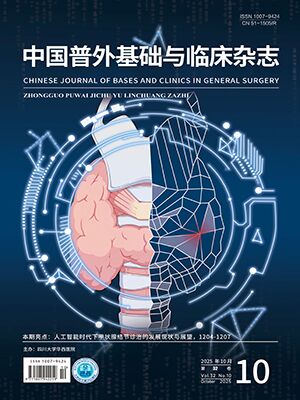| 1. |
ünal E, ?dilman ?S, Akata D, et al. Microvascular invasion in hepatocellular carcinoma. Diagn Interv Radiol, 2016, 22(2): 125-132.
|
| 2. |
Sumie S, Nakashima O, Okuda K, et al. The significance of classifying microvascular invasion in patients with hepatocellular carcinoma. Ann Surg Oncol, 2014, 21(3): 1002-1009.
|
| 3. |
王家臣, 牛蕾, 段崇鋒, 等. 肝細胞肝癌微血管侵犯的 MRI 研究. 醫學影像學雜志, 2018, 28(6): 971-974.
|
| 4. |
Schlichtemeier SM, Pang TC, Williams NE, et al. A pre-operative clinical model to predict microvascular invasion and long-term outcome after resection of hepatocellular cancer: The Australian experience. Eur J Surg Oncol, 2016, 42(10): 1576-1583.
|
| 5. |
Weissleder R, Mahmood U. Molecular imaging. Radiology, 2001, 219(2): 316-333.
|
| 6. |
Ni DL, Zhang jw, Bu WB, et al. Dual-targeting upconversion nanoprobes across the blood-brain barrier for magnetic resonance/fluorescence imaging of intracranial glioblastoma. ACS Nano, 2014, 8(2): 1231-1242.
|
| 7. |
Mi P, Kokuryo D, Cabral H, et al. A pH-activatable nanoparticle with signal-amplification capabilities for non-invasive imaging of tumour malignancy. Nat Nanotechnol, 2016, 11(8): 724-730.
|
| 8. |
Sun CC, Qu XJ, Gao ZH. Integrins: players in cancer progression and targets in cancer therapy. Anticancer Drugs, 2014, 25(10): 1107-1121.
|
| 9. |
Salvatore A, Montis C, Berti D, et al. Multifunctional magnetoliposomes for sequential controlled Release. ACS Nano, 2016, 10(8): 7749-7760.
|
| 10. |
Choi JY, Lee JM, Sirlin CB. CT and MR imaging diagnosis and staging of hepatocellular carcinoma: partⅡ. Extracellular agents, hepatobiliary agents, and ancillary imaging features. Radiology, 2014, 273(1): 30-50.
|
| 11. |
Runge VM. Safety of the gadolinium-based contrast agents for magnetic resonance imaging, focusing in part on their accumulation in the brain and especially the dentate nucleus. Invest Radiol, 2016, 51(5): 273-279.
|
| 12. |
Lee S, Kim SH, Lee JE, et al. Preoperative gadoxetic acid-enhanced MRI for predicting microvascular invasion in patients with single hepatocellular carcinoma. J Hepatol, 2017, 67(3): 526-534.
|
| 13. |
Ahn SY, Lee JM, Joo I, et al. Prediction of microvascular invasion of hepatocellular carcinoma using gadoxetic acid-enhanced MR and (18)F-FDG PET/CT. Abdom Imaging, 2015, 40(4): 843-851.
|
| 14. |
徐萍, 黃夢琪, 廖冰, 等. Gd-EOB-DTPA MRI 動態增強預測孤立性肝細胞癌微血管侵犯的單因素及多因素回歸分析. 影像診斷與介入放射學, 2017, 26(1): 31-36.
|
| 15. |
劉曦嬌, 唐鶴菡, 宋彬, 等. 釓塞酸二鈉增強 MRI 肝膽期信號與肝細胞肝癌分化程度的關系. 中國普外基礎與臨床雜志, 2014, 21(12): 1583-1586.
|
| 16. |
張志敏, 謝冬敏, 許映斌, 等. 超聲造影在肝細胞癌病理預后因素分析中的應用. 中國醫學創新, 2016, 13(17): 66-69.
|
| 17. |
Zhou Z, Han Z, Lu ZR. A targeted nanoglobular contrast agent from host-guest self-assembly for MR cancer molecular imaging. Biomaterials, 2016, 85: 168-179.
|
| 18. |
Le Bihan D, Breton E, Lallemand D, et al. MR imaging of intravoxel incoherent motions: application to diffusion and perfusion in neurologic disorders. Radiology, 1986, 161(2): 401-407.
|
| 19. |
白婷婷, 邊杰. 釓塞酸二鈉增強 MRI 與 IVIM-DWI 在肝細胞癌微血管侵犯診斷中的價值研究. 大連醫科大學, 2018.
|
| 20. |
宋瓊, 曾蒙蘇. MR 非增強與增強灌注成像評估肝癌微循環功能狀態的價值研究. 復旦大學, 2013.
|
| 21. |
Lemke A, Stieltjes B, Schad LR, et al. Toward an optimal distribution of b values for intravoxel incoherent motion imaging. Magn Reson Imaging, 2011, 29(6): 766-776.
|
| 22. |
孔源, 李文美. 磁共振動態增強成像在原發性肝癌診斷的應用研究. 中國臨床新醫學, 2016, 9(5): 387-390.
|
| 23. |
Lei Z, Li J, Wu D, et al. Nomogram for preoperative estimation of microvascular invasion risk in hepatitis B virus-related hepatocellular carcinoma within the Milan criteria. JAMA Surg, 2016, 151(4): 356-363.
|
| 24. |
Poté N, Cauchy F, Albuquerque M, et al. Performance of PIVKA for early hepatocellular carcinoma diagnosis and prediction of microvascular invasion. J Hepatol, 2015, 62(4): 848-854.
|
| 25. |
李文柱, 蘇丹柯. 能譜 CT 預測肝細胞癌微血管侵犯的可行性研究. 廣西醫科大學, 2016.
|
| 26. |
Watson EC, Grant ZL, Coultas L. Endothelial cell apoptosis in angiogenesis and vessel regression. Cell Mol Life Sci, 2017, 74(24): 4387-4403.
|
| 27. |
Liu CH, Ren J, Liu CM, et al. Intracellular gene transcription factor protein-guided MRI by DNA aptamers. FASEB J, 2014, 28(1): 464-473.
|
| 28. |
Upheber S, Karle A, Miller J, et al. Alternative splicing of KAI1 abrogates its tumor-suppressive effects on integrin αvβ3-mediated ovarian cancer biology. Cell Signal, 2015, 27(3): 652-662.
|
| 29. |
Zhang N, Cai X, Gao W, et al. A multifunctional theranostic nanoagent for dual-mode image-guided HIFU/chemo-synergistic cancer therapy. Theranostics, 2016, 6(3): 404-417.
|
| 30. |
Zhou Z, Wu X, Kresak A, et al. Peptide targeted tripod macrocyclic Gd (Ⅲ) chelates for cancer molecular MRI. Biomaterials, 2013, 34(31): 7683-7693.
|
| 31. |
Lei Y, Hamada Y, Li J, et al. Targeted tumor delivery and controlled release of neuronal drugs with ferritin nanoparticles to regulate pancreatic cancer progression. J Control Release, 2016, 232: 131-142.
|
| 32. |
Zhou Y, Gao JB, Xu H, et al. Evaluation of neovascularization with spectral computed tomography in a rabbit VX2 liver model: a comparison with real-time contrast-enhanced ultrasound and molecular biological findings. Br J Radiol, 2015, 88(1055): 20140548.
|
| 33. |
Hirokawa F, Hayashi M, Miyamoto Y, et al. Outcomes and predictors of microvascular invasion of solitary hepatocellular carcinoma. Hepatol Res, 2014, 44(8): 846-853.
|
| 34. |
李迪, 肖喜剛. 原發性小肝癌微血管侵犯的寶石能譜 CT 分析. 檢驗醫學與臨床, 2018, 15(5): 605-607, 610.
|
| 35. |
Hu S, Huang W, Chen Y, et al. Spectral CT evaluation of interstitial brachytherapy in pancreatic carcinoma xenografts: preliminary animal experience. Eur Radiol, 2014, 24(9): 2167-2173.
|




